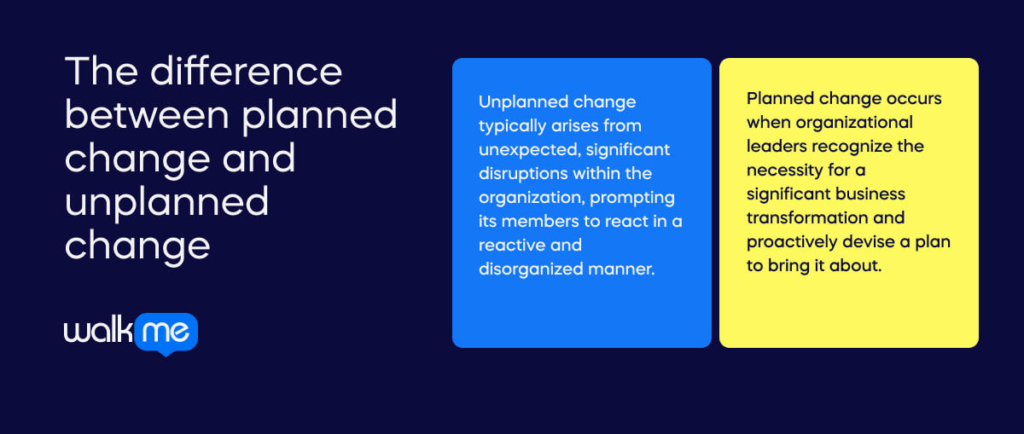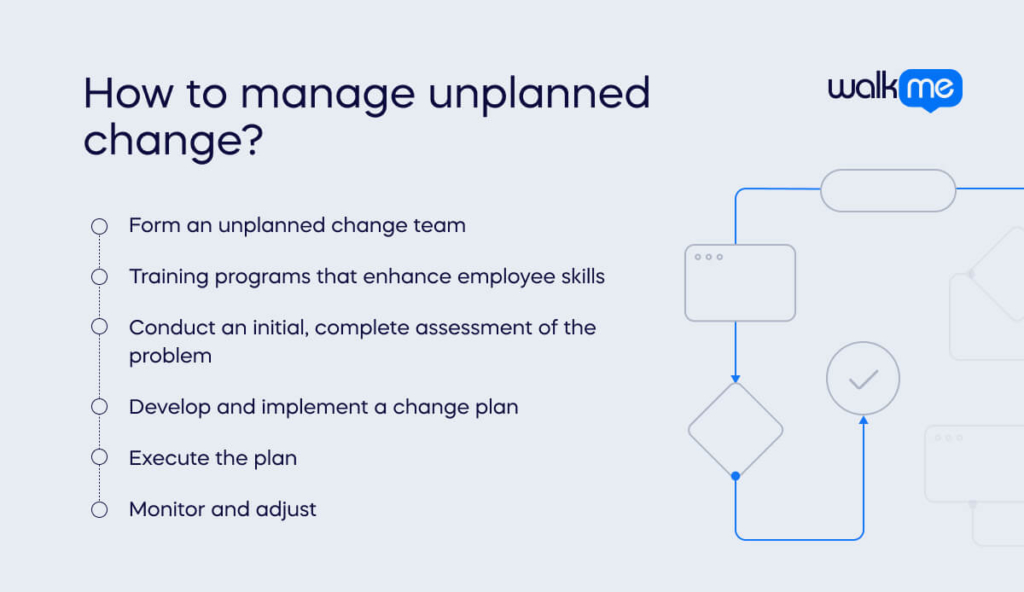Organizations can often carefully deliberate and strategize their changes, dedicating considerable time and effort to ensure that transitions are well-planned, efficient, and effectively managed.
They engage in extensive project planning and incorporate a change management process to guarantee that employees are adequately prepared for any changes in processes, procedures, or structures that may occur.
This systematic approach allows for a smoother transition and minimizes disruption to daily operations.
However, the business landscape is often unpredictable, and organizations can find themselves in situations where they must adapt on the fly due to unforeseen circumstances.
These unexpected changes can manifest in various forms, such as sudden economic downturns, unpredictable shifts in market dynamics, or unforeseen resource constraints.
When faced with these abrupt and unplanned changes, even the most well-prepared organizations may need help to maintain their usual level of structure and organization.
Therefore, it becomes imperative for organizations to be ready for unforeseen changes by formulating flexible and adaptable strategies to respond to unexpected challenges or opportunities that may surface swiftly.
This article will delve into unplanned change, covering its definition, causes, distinction from planned change, effective management strategies, real-world examples, and its pros and cons.
What is unplanned change?
Unexpected organizational changes frequently arise from significant, unforeseen events. These incidents may involve a manager departing suddenly, declining product and service quality, resulting in client attrition, and other disruptive circumstances like an economic crisis.
What are the causes of unplanned change?

Unplanned changes can arise from either external or internal factors.
Internal unplanned changes can stem from the departure of a highly valued employee or the abrupt severance of business ties with a significant client, particularly if they opt to collaborate with a competitor.
Furthermore, the potential fallout from sensitive information falling into the wrong hands cannot be underestimated. It has the potential to wreak havoc on all parties involved and expose your business to significant financial losses and legal liabilities.
Additionally, unforeseen events like fires, floods, tornadoes, hailstorms, or vandalism can inflict substantial damage and disrupt your business operations, bringing them to an abrupt standstill. Without adequate preparation, the financial repercussions of such damage can be crippling.
Another internal factor leading to unplanned changes is the presence of organizational performance gaps. These gaps manifest as declining profit margins, underperforming product lines or services, or a slowdown in sales due to unexpected factors.
On the external front, unplanned changes can be triggered by changes in governmental regulations. Alterations in government regulations can significantly impact an organization’s business environment and operational procedures, especially in highly competitive sectors.
Economic globalization and liberalization have led to regulatory changes, such as delicensing and currency conversion, that aim to help organizations remain competitive and attain desired profit margins.
Furthermore, global economic competition exerts immense pressure on organizations, compelling them to adapt to remain competitive. Organizations must engage in advertising and communication campaigns to gain a substantial market share and expand their customer base.
These external factors create an environment where adaptability becomes essential for survival and growth in fierce global competition.
The difference between planned change and unplanned change

The distinction between planned and unplanned change is relatively straightforward. Unplanned change typically arises from unexpected, significant disruptions within the organization, prompting its members to react in a reactive and disorganized manner.
Unplanned change scenarios include the abrupt departure of the CFO, sudden public relations crises, rapid product performance deterioration leading to customer loss, or other disruptive events that catch the organization off guard.
Conversely, planned change occurs when organizational leaders recognize the necessity for a significant business transformation and proactively devise a plan to bring it about. The successful implementation of strategic plans, reorganization strategies, or other substantial change initiatives marks this type of change.
It is worth noting that even though planned change is based on proactive and well-thought-out plans, it often unfolds in a more chaotic and disruptive manner than initially anticipated by those involved. In essence, planned change is a deliberate choice, such as implementing a new strategic direction for the marketing team or a comprehensive team reorganization.
In contrast, no one selects unplanned change, which encompasses unforeseen developments like the failure of a new product, the departure of key personnel, or a reputational crisis that catches the organization off guard.
How to manage unplanned change

Managing unplanned change aims to minimize its adverse effects and facilitate a smooth transition into the new situation. To navigate unexpected changes successfully, consider the following steps:
Form an unplanned change team
Create a dedicated cross-functional team responsible for planning, executing, and monitoring the change. This type of team will set the tone for the entire organization through their leadership vision.
Include individuals who are well-respected, informed, and committed to driving the change at their respective levels. Appoint a leader within this team who assumes ultimate responsibility and accountability for the change’s success, offering guidance, resources, and leadership to the team.
In addition, a change management agent can be employed to play a pivotal role in disseminating messages and clarifying employee expectations throughout the change process. They serve as communicators, advocates, coaches, liaisons, and resistance managers.
People managers make effective change agents due to their proximity to the action and demonstrated leadership skills. However, individual contributors with the necessary commitment and energy can also excel in this role.
Conduct an initial, complete assessment of the problem
Assess the scope and scale of the change thoughtfully. This step involves gathering information, analyzing data, and conducting interviews to understand the root cause of the issue and determine the most effective approach to address it.
Additionally, evaluate the change’s impact on various aspects of the organization to identify potential risks and challenges.
Develop and implement a change plan
After thoroughly assessing the unplanned issue, create a comprehensive plan to address the problem or event. This plan should outline specific actions, allocate necessary resources, and establish a timeline for implementation.
Effective communication is important during this phase to build understanding and gain employee buy-in. Addressing individual emotions is crucial to minimizing resistance to change and fostering trust.
Execute the plan
Execution requires active change leadership involvement. Change leaders should provide resources and lead by example, demonstrating their commitment to the change.
Regular monitoring and quick identification of obstacles are critical to staying on track. Daily standup meetings or other forms of frequent communication can help the team stay connected and agile.
It’s also important to recognize the importance of employee morale in engagement and productivity. Schedule regular check-ins with team members to gauge their well-being and adapt existing employee engagement strategies as needed to provide support during times of uncertainty.
Monitor and adjust
Continuously assess the change’s effectiveness. Collect feedback from stakeholders, evaluate performance, celebrate achievements, and be ready to adjust the plan as necessary to optimize results. The goal is to ensure the change effectively addresses the problem or event while avoiding unintended negative consequences.
Practical examples of unplanned change
While unplanned change can often be challenging to manage and prepare for, here are two examples of how companies can deal with it and come out stronger:
Boston Medical Center
Kate Walsh, CEO of Boston Medical Center, played a vital role in the first wave of COVID-19, an unplanned change. As the pandemic began, the urgency to prepare Boston was evident. Walsh’s initial focus was on ensuring the safety of staff and patients.
Like many nationwide, Boston Medical Center faced challenges in acquiring personal protective equipment (PPE). Walsh, along with other hospital CEOs, coordinated efforts to ensure staff were informed about the availability of masks and other necessary equipment. This transparency helped build staff trust.
It also worked with the Boston Health Care for the Homeless Program, a vital community health center, and guided patient cohorts during the pandemic. Four categories of patients were identified: suspected COVID-positive, asymptomatic COVID-positive, symptomatic COVID-positive, and those requiring hospitalization.
Walsh and her team realized that not all COVID-19-positive individuals needed hospital care but required a place to recover. Consequently, a vacant hospital building and a convention center in Boston were repurposed for these patients.
This program was instrumental in enabling the Boston Medical Center to manage patient care effectively. Comparatively, Walsh believes their strategies helped prevent system overload, unlike some New York hospitals that serve similar populations.
The infection-control team at Boston Medical Center extended their training and discussions beyond physicians to include employees involved in various aspects of patient care.
Walsh also recognized the psychological impact of the pandemic on healthcare workers. She engaged in video chats with the in-house social worker to address the trauma experienced by staff. Additionally, the hospital established a confidential resource for employees, offering 24/7 access to a behavioral health specialist.
Understanding the challenges of the pandemic, the greater Boston community showed remarkable generosity, donating over $11 million for COVID-19-related activities. The hospital also took extra steps to protect its employees, including providing accommodations and meals for COVID-positive staff to reduce family exposure risk.
To keep everyone informed, daily COVID updates were communicated to all employees. These updates covered patient and staff infection rates, recoveries, and other relevant information. This approach ensured that protocol changes, such as PPE usage and other support services, were effectively communicated.
Amazon
Shoppers, facing store closures and empty shelves, increasingly relied on Amazon for COVID-19 protection products such as hand sanitizer, face masks, and disinfectants.
This surge in orders initially overwhelmed Amazon, making it difficult to maintain its two-day delivery promise, a key feature of its $119 annual Prime membership.
The company faced shortages of high-demand items like hand sanitizer and paper towels. It dealt with widespread price gouging, and made swift adjustments in its warehouses to ensure employee safety without significantly reducing the work pace.
Jeff Bezos, Amazon’s CEO, redirected his focus primarily toward COVID-19 challenges, moving away from longer-term projects and ventures like Blue Origin. Bezos and Amazon’s senior leadership held daily meetings to address inventory issues and keep abreast of coronavirus developments. The company’s supply chain, its critical component, was heavily impacted by the pandemic and struggled to return to normalcy.
Months into the pandemic, Amazon continued to recover from these inventory disruptions. The company faced a backlog of inbound shipments when it resumed accepting nonessential items. Additionally, due to ongoing space constraints, Amazon imposed restrictions on the volume of goods sellers could store in its U.S. warehouses.
Amazon also came under significant public scrutiny regarding its treatment of warehouse employees during the pandemic. Given the high-speed work environment, workers raised concerns about insufficient safety measures against the virus. Calls for action came from lawmakers, regulators, worker rights groups, and some of Amazon’s corporate employees.
In response, Amazon reported implementing over 150 process updates in its warehouses to reduce virus transmission, including enhanced cleaning, social distancing measures, and mandatory mask-wearing. Furthermore, the company expanded coronavirus testing among its employees, conducting tests at nearly a dozen warehouses by July, to improve the employee experience.
What are the advantages of unplanned change?
Unplanned change, while challenging to deal with, can allow individuals to explore a reactive way of thinking.
Develops the ability for agile problem-solving
Reactive thinking empowers employees to respond swiftly to issues as they arise. This organizational agility is especially valuable in fast-paced environments where delays can have significant consequences.
When employees can think reactively, they are more likely to take immediate action to address problems, leading to quicker resolutions.
Fosters creativity and innovation
Unplanned change disrupts routines and opens the door to creative thinking. When plans aren’t rigidly set, individuals can explore new ideas and embrace innovative approaches.
This flexibility allows quick decision-making based on newly received information, leading to novel solutions and more dynamic problem-solving.
Maintains focus on the present
Leaders and individuals dealing with unplanned change can shift their focus away from worrying about future uncertainties.
Instead, they concentrate on the immediate tasks and challenges, making progress on projects despite the disruptions.
Promotes resilience and learning
Viewing unplanned changes as opportunities for growth and learning can help individuals and organizations adapt more effectively.
Each challenge, even if it results from an unplanned change or perceived failure, can be seen as a chance to refine strategies and change processes.
Enhances adaptability and preparedness
Embracing reactive thinking in the face of unplanned change also enhances overall adaptability.
Employees and leaders accustomed to responding quickly and creatively to unexpected situations are better prepared to handle future challenges confidently.
What are the disadvantages of unplanned change?
A focus on the short-term at the expense of long-term quality
Reacting to unplanned changes often leads individuals to prioritize solving immediate problems, neglecting to consider future business resilience.
Focusing on quick fixes may result in lower-quality work in the long run, as individuals may not anticipate and address underlying or anticipated challenges.
While reacting to immediate tasks can create a sense of accomplishment, it may lead to overlooking more substantial, developing problems in the background.
Failure to proactively address significant issues can result in larger crises down the line, which might have been preventable with a more proactive change management approach.
Inefficient use of resources
Responding reactively to unplanned change often requires shifting team members from one task to another or dealing with rapidly changing information.
This can be highly inefficient, frustrating team members and potentially seeking more satisfying opportunities elsewhere.
Additionally, reacting to unplanned change makes identifying the root causes of problems challenging, as immediate symptoms demand attention.
Additionally, individuals are less likely to spot strategic opportunities that proactive change managers seize as urgent matters consume their attention.
An increase in stress levels
Dealing with one crisis after another in a reactive mode can be stressful and mentally draining. The lack of time to decompress and reflect can cause stress, impacting mental and emotional well-being.
While some individuals may cope with the constant pressure of reacting to change, not all team members possess the same level of resilience. The stress and demands of reactive approaches can lead to burnout or decreased job satisfaction among team members.
Final steps on unplanned change
Change can take different forms, from purposeful and intentional to entirely unforeseen.
Change management typically prepares individuals for anticipated changes using the Kurt Lewin Change Model. However, there are instances, such as the COVID-19 outbreak, where change is imposed upon us without any prior warning.
The global COVID-19 outbreak is a stark example of a radical and unexpected change that has impacted individuals and organizations worldwide. Within a matter of days, established routines at home and in the workplace underwent significant revisions, thrusting everyone into the challenging task of adapting to unforeseen and unwelcome change.
The key to effective unplanned change management is guiding people to embrace and adapt to the change while minimizing, mitigating, or circumventing undesirable consequences. This entails recognizing that we may not control the unfolding events, but we have agency over our roles and responses in the face of change.

